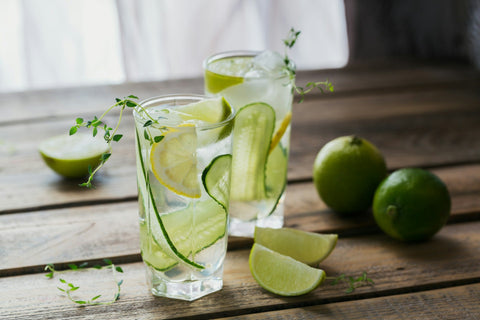When the sun blazes and temperatures soar, your body works harder to stay balanced. Sweating may cool you down, but it also drains fluids, electrolytes, and energy. Dehydration, sluggish digestion, and even skin breakouts become more common in hot months. That’s where smart seasonal eating steps in.
Adjusting your meals and drinks for summer isn’t just refreshing—it’s necessary. Summer nutrition tips can help you avoid heat exhaustion, feel lighter, and support digestion without weighing you down. This guide explores what to eat in hot weather, the best foods for hydration, and simple, healthy summer drinks that help you thrive through every heatwave.
How Hot Weather Affects Your Body

High temperatures trigger the body to sweat, which cools you but also leads to mineral loss, especially sodium, potassium, and magnesium. Without replacing these, you may feel drained, dizzy, or mentally foggy.
Even mild dehydration affects energy, mood, and digestion. Your body needs water not only to regulate temperature but also to move food through your gut, produce digestive enzymes, and keep your skin supple. So, hydration foods and natural electrolyte drinks should be central to your summer routine.
To protect your energy and digestion, you need more than just water. Focus on seasonal ingredients rich in water, fibre, and cooling nutrients like vitamin C, magnesium, and antioxidants.
What to Eat in Summer — Cooling, Light, and Hydrating Foods
Summer is the season to simplify. Your body naturally craves foods that hydrate, soothe, and feel light. Here are some of the best summer foods to add to your warm-weather plate:
Cucumbers offer more than crunch. They’re nearly all water, which helps hydrate from within. They also calm digestive inflammation.
Watermelon is a summer favorite for a reason. It’s sweet, juicy, and loaded with lycopene—an antioxidant that protects against sun damage and supports circulation (1).
Leafy greens, such as spinach and romaine, are easy to digest and rich in magnesium, a key mineral lost in sweat. These greens support bowel regularity and nerve balance (2).
Yogurt cools the gut while replenishing healthy bacteria. It’s protein and probiotics help digestion and keep you fuller between meals.
Berries like blueberries and strawberries are perfect cooling foods for summer. They are rich in polyphenols, which protect skin from oxidative stress and reduce inflammation (3).
Citrus fruits—lemons, limes, oranges—add a refreshing burst to salads, water, or smoothies. Their high vitamin C content supports immunity and collagen production, both of which take a hit from sun exposure (4).
Zucchini, tomatoes, and bell peppers round out the list of hydrating vegetables. They’re naturally high in water and vitamin A, making them excellent for skin and digestion.
Eating more of these foods supports hydration while avoiding heavier, greasy meals that can slow you down in the heat.
What to Drink to Stay Hydrated (Without Excess Sugar)
Staying cool isn’t just about what you eat—it’s what you sip, too. But not all beverages are equal. Skip sugary sodas and caffeine-heavy energy drinks, which are classic foods that dehydrate you. Instead, try these healthy summer drinks:
Infused water with mint, lemon, or cucumber turns plain hydration into something you’ll crave. The added ingredients may also aid digestion and reduce bloating.
Coconut water is a powerhouse of natural electrolytes like potassium and magnesium. It replenishes minerals lost through sweat, without artificial flavors or added sugar.
Iced herbal teas, like hibiscus or chamomile, are naturally caffeine-free and cooling. Hibiscus, in particular, is rich in antioxidants and has mild diuretic properties that reduce puffiness.
Homemade smoothies with watermelon, berries, and chia seeds are ideal for breakfast or a cooling snack. Chia adds fibre and omega-3s, while the fruit hydrates and energizes.
These drinks keep your fluids up while giving your body the nutrients it needs to function in the heat.
Summer Meal Ideas and Practical Tips
Need ideas for easy summer meals? Start with cold grain salads. Try mixing quinoa with chopped cucumbers, cherry tomatoes, parsley, and a splash of lemon. It’s light, nourishing, and easy to prep in advance.
Build your breakfast around fruit and protein. A yogurt parfait layered with berries and flax offers hydration, fibre, and gut support.
Grilled vegetables—like zucchini and peppers—wrapped in flatbread with hummus make for a satisfying but not heavy lunch or dinner. For extra hydration, add a handful of greens and a squeeze of citrus.
And don’t forget to prep ahead. Keep cut watermelon, citrus wedges, and jars of infused water in the fridge. This makes it easier to grab something refreshing when you’re hot or tired.
The Bottom Line
Your body tells you what it needs in summer: lightness, hydration, and nourishment. When you respond with seasonal choices, you support every part of your system—from your skin to your gut to your energy levels.
By following these summer nutrition tips, including what to eat in hot weather and how to choose hydration foods and natural electrolyte drinks, you can stay balanced all season long.
Eat intuitively. Drink wisely. Let summer be a time of feeling light, clear, and nourished.
References
1. Edwards AJ, Wiley ER, Brown ED, Clevidence BA, Vinyard BT, Collins JK, et al. Consumption of Watermelon Juice Increases Plasma Concentrations of Lycopene and β-Carotene in Humans. The Journal of Nutrition. 2003 Apr 1;133(4):1043–50.
2. Schwartz R, Spencer H, Welsh JJ. Magnesium absorption in human subjects from leafy vegetables, intrinsically labeled with stable 26Mg. Am J Clin Nutr. 1984 Apr;39(4):571–6.
3. Bouyahya A, Omari NE, EL Hachlafi N, Jemly ME, Hakkour M, Balahbib A, et al. Chemical Compounds of Berry-Derived Polyphenols and Their Effects on Gut Microbiota, Inflammation, and Cancer. Molecules. 2022 May 20;27(10):3286.
4. Pérez-Sánchez A, Barrajón-Catalán E, Caturla N, Castillo J, Benavente-García O, Alcaraz M, et al. Protective effects of citrus and rosemary extracts on UV-induced damage in skin cell model and human volunteers. Journal of Photochemistry and Photobiology B: Biology. 2014 Jul 5;136:12–8.


